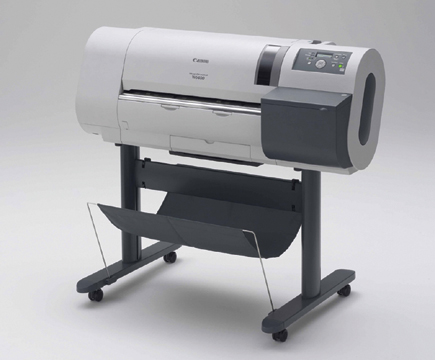Getting The BIG Picture With The Canon W6400; Large Format Printers, Now For Photographers
Long the realm of commercial labs due to their cost and complexity, a new breed of large format printers are being aimed at photographers, both pro and advanced amateurs, who want to take control of their gallery, portrait, and wedding prints. New inks, simplified software, and vastly enhanced workflows make these printers attractive to photographers who make the commitment to creating their own large prints (20x24" and up) and who have the demand for their work and imaging services. Moving up to a larger format also means a budgetary commitment, but at about $7 for a 20x24" print, one that will rival that produced by a commercial lab, the costs can be quickly justified by those who charge many times more than that for such enlargements to their clientele, whether they be art buyers or brides and grooms.
 |
|
|
We recently had the opportunity to work with the Canon imagePROGRAF W6400
(up to 24" wide, roll, $3495) and found that it demanded little more than
desktop printing experience, assuming, of course, that your monitor has been
calibrated properly. Speedy and quiet, the Canon printer is an eye opener in
the possibilities it affords for both dedicated photographers and pros looking
to expand their product offerings. The unit also delivered sparkling color and
monochrome prints unbothered by shifts or metamerism, a breakthrough for those
seeking to make large format black and white prints.
The Canon W6400 (and its larger cousin, the W8400 for 44" wide prints,
at $5995) works with Bubble Jet Canon technology, with an expanded 6+1 inkset
that includes a swappable matte black when using "fine art" heavier
weight stock. The highest resolution is 2400x1200, with 7680 nozzles and a four-picoliter
droplet size. For those familiar with the past manifestation of this model,
the W6200, picoliters went from eight to four (smaller nozzle size being better),
and resolution has been upgraded from 1200x1200 to 2400x1200.
Increased resolution, however, is just part of the story, and the remainder
is the reason why we agreed to try out this printer. Substantial changes have
been made to make this printer attractive to photographers with desktop printing
experience, including ease of use software and a greatly expanded array of substrates,
with printing surfaces under the Canon brand going from 8-28 types. This means
that there's a good chance that whatever surface you might want to use
(including a Canon/Hahnemühle co-branded paper) there will be a custom
profile available in the driver. With the cost and work involved in custom profiling
these days, these paper choices and accompanying supplied profiles will make
getting good prints a much easier task.
 |
|
|
Granted, some of the available paper/substrate choices are aimed at the graphic
and commercial markets, to which this printer is also being pitched. But for
photographers there is Canon-branded Premium RC Photomatte, Premium RC Photogloss,
Graphic Matte Canvas, Photo Rag 188gsm and 308gsm (both by Hahnemühle),
and Canon Enhanced Velvet 255gsm by Somerset. Prints can be made with a border
or borderless.
Of course, printing is made easier, or more difficult, by the accompanying software.
Here, Canon has done their homework and has supplied both simplified editing
tools in their own Digital Photo Print Pro (with an interface that will be quite
familiar to EOS digital SLR users) and perhaps most pertinent to desktop printers,
an Adobe Photoshop plug-in. To access this you first do the work you want on
the image in Photoshop and then go to File>Export to bring the image into
the Canon print driver. Here's where you make all the paper, profiling,
and sizing decisions. There's a live preview as you change settings, which
gives you a good idea of how each decision (particularly the paper selections)
will affect the image. If desired you can also tweak color and contrast settings
here as well. By the way, the plug-in allows for printing 16-bit images in 10-bit
RGB, compared to 8 bit from Photoshop to the driver, says Canon.

































